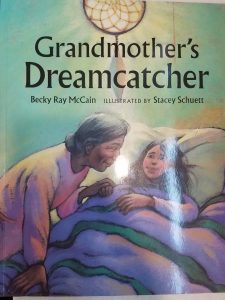
Title: Grandmother’s Dreamcatcher
Author: Becky Ray McCain
Illustrator: Stacey Schuett
Publisher and Year: Albert Whitman and Company, 1998
Number of pages: 32
Tags/Themes: Culture, Family, Fiction, 2-3, Evan White
Genre: Children’s, Cultural, Realistic Fiction, Picture Books, Native Americans, Family
Descriptive Annotation: A little Chippewa girl is dropped off at her grandmother’s house while her parents look for a new house. While the girl stays over, she has night terrors. Her Chippewa grandmother decides to teach her granddaughter how to make a dream catcher. As they were crafting the dream catcher, the grandmother told a story about how the dream catcher came to be. The “Great Spirit” sent a vision to a tribal member on a spider creating a giant web to catch all the bad dreams. Once they made a dream catcher, the little Chippewa girl stopped having night terrors and made two more dream catchers for her parents. At the back of the book, there are instructions on how to make a dream catcher.
Classroom Application: I would use this text to reinforce art and culture of Native Americans. I think this book tells a feel-good family story that teaches about the significance of dream catchers. In the story, the grandma explains how the dream catcher is important to their family and cultural roots. Then I would teach the students the differences between Native American dream catchers and American dream catchers. Typically, American dream catchers are more complex and flashier, while Native American dream catchers have beads and feathers, nothing flashy or anything for aesthetic purposes. This could be a good time to talk about respecting Native American culture and how making dream catchers more ascetically complex is disrespecting their culture. I also think this story would be really good with compare and contrast. There are different origin stories for the dreamcatcher, and it could be a fun compare and contract unit to read different stories on how the dreamcatcher was created.
Linguistic and Cultural Diversity Analysis: This story represents Native American culture but more specifically the Chippewa story of the dream catcher’s origin story. This story fosters a respect for Native Americans and respect to their values and little aspects of their culture. The students would learn a little history of the origin of dream catchers . “So her grandmother did what our people still do. She asked the Great Spirit for help, and she was given a vision of a dreamcatcher circle. It had feathers on it just like yours and mine, but inside was empty. When this grandmother hung the dreamcatcher above the grandchild’s head, a spider came down and made the web inside. All the child’s dreams were then caught in that web to go to the Great Spirit. Only the sweet dreams were permitted to go back to the girl” (16). I think you can have a discussion on how values and cultural ideas get passed down to continue and how individuals can support cultural values, like how the grandma taught her granddaughter . Then in the story, the little girl makes a dreamcatcher for her parents to continue their cultural values. “Each day, Grandmother and I are busy with our work. We sew beads on leather to make hair ties for Mama. Grandmother takes me fishing, and I find a special feather just for Daddy. We make a dreamcatcher for mama and Daddy” (27). To introduce this book, I would ask the students what they know about dream catchers and their origins and how they imagine them. They could draw or describe what they have seen in their lives. The drawings or description can be used to compare after the book and looking at traditional dream catchers.
